The simplest ways to attract an audience to a film are including well-known actors, advertising the movie – making a trailer, and announcing a certain genre the film belongs to. The viewers find particular genre movies attractive because they know what to expect from it. Categorizing films into genres also helps people find certain films they want to see, because they would search the among the genres that appeal most to them. There are some movies that don’t belong to just one genre, but two or ever more – they’re called hybrids. Some examples involve Westworld (sci-fi/Western), Alphaville (sci-fi/noir), American Psycho (horror/comedy), All About the Benjamins (action/comedy/crime). Some genres have very similar features, with only a few certain details that differ, so one could argue that a film belonging to various genres is only better described upon a quick glance. Some examples may include Mulholland Drive (psychological thriller/mystery/drama), Great Expectations (drama/romance), Dragon Eyes (crime/drama/action), Inception (action/adventure/mystery).
The Shawshank Redemption belongs to the prison genre. It is one of the most iconic movies of the genre. Some other films I associate with the prison genre include Cool Hand Luke, Stone, Greenfingers, Jailbait, and The Green Mile. The general concept of a prison movie is the escape of the prison and showing the characters’ life inside it. Prison movies show how incarceration affects the characters. The typical situations in which the characters find themselves involved include gang fights, trying to earn respect and trust from their inmates, getting tormented inhumanely by the strict guards and other prisoners, and, of course, the escape. The movies take place inside the prison and in its back yard. The usual locations inside the prison include the prison cells, laundry rooms, the warden’s office, the cafeteria, sometimes a library and shower rooms. In terms of iconography, we associate bars, prison jumpsuits, chains, brutal guards, prison bunk-beds, prisoners taking their pills, and often the prisoners’ religious belongings with the prison genre, and we expect to see them in the movies.
I shall be analyzing the rooftop tarring scene from Shawkshank Redemption.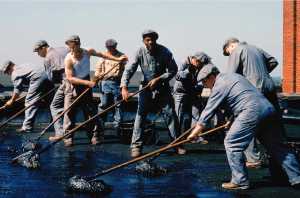
In this scene Andy, Red and other prisoners are tarring the rooftop while the guards discuss the warden’s issue of having the money his dead brother left for him getting taxed by the government. As Andy overhears this, he bravely goes over to the warden and tells him how he can keep all the money tax-free if he gives it as a present to his wife. The warden was angry with Andy at first and held him on the edge of the roof, about to let go, but after hearing this, he releases Andy and allows him to finish. Andy promises he will do all the paperwork in exchange for 3 beers for each of the prisoners who were working on the roof. Everyone is in disbelief of Andy’s courageous act. Next we see all the prisoners drinking beers as a success of Andy’s offer. The warden and the guards are sitting on the edge of the roof and watching the prisoners feel free again. Andy feels powerful and manly, and he has gained the prisoners’ trust and friendship.
We see the rooftop and the prisoners tarring it at the beginning of the scene. The prisoners have brooms and are dressed in old, saggy work clothes. They’re working hard because it is not often that they get to get outside the prison walls or the exercise yard and do other work than laundry. Andy looks composed throughout the whole scene, and brave when he confronted the warden. After he had succeeded, his face expression was more relaxed – he looked very satisfied with himself. Red also seemed proud of Andy’s success. The warden looked very angry as he was about to throw Andy off the edge of the roof, but after he had given in and accepted Andy’s offer, he seemed slightly embarrassed. The lighting was direct sunlight – the sky was clear, and the scene was filmed in broad daylight. The camera was mostly focused on capturing the characters’ facial expressions, because they were very important to the scene. There was a memorable and intense shot of the warden holding Andy on the edge – the camera was pointed at Andy and looking down to show the audience how high the roof is.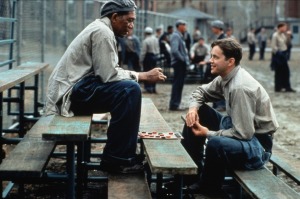
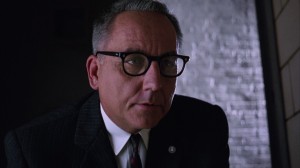
Andy, Red and the warden are the main characters of the film. Andy is the clever protagonist who helps everyone around him during his imprisonment. He takes upon the role of a banker, doing the guards’ taxes, helps his in-mates out, providing them with books to read and, as mentioned before, getting his friends fresh beers through negotiating with the dehumanized, merciless prison guard. Red is Andy’s closest prison friend who had been institutionalized for the most of his life. He always gets denied at his parole hearings. Red is the ”boss” of the prisoners; he’s very authoritative, and he’s prominent for getting contraband into the prison for his in-mates. The main antagonists are the warden and the brutal guard whom Andy courageously confronted on the rooftop. The guard is the most brutal of them all, and he is feared by the prisoners as they have seen how badly he had beaten up rebellious prisoners before. The warden is a corrupt character, and he is a very religious man, often quoting Bible verses throughout the movie.
The narrative structure of Shawshank Redemption is non-linear. The focus shifts between different characters throughout the movie and we are shown several flashbacks. Red narrates some of the story from his point of view. The set up shows how Andy gets convicted of murder and sentenced at Shawshank. The conflict comprises several quarrels with the warden, the guards, some prison in-mates and the gang. As Andy is a smart man – much smarter than the average prisoner – he has solutions for every problem to arise. The resolution is Andy’s surprising escape from Shawshank and Red’s last parole hearing.
The themes commonly dealt with in prison films involve friendship, loyalty, hope, identity, injustice, dignity, masculinity, humanity, time and freedom. The prison movies often criticize the penal system, showing how far the prisoners would go and how they’d allow themselves to be treated just to break out of entrapment. Shawshank Redemption touches this subject as well, showing how the prisoners get mistreated, which makes us question whether the ones imprisoned are really the true danger to society.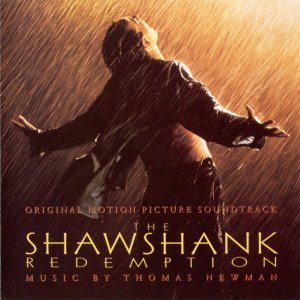
The film also includes some religious symbolism. As the warden was a very religious man and preached to the newcomers to the prison and quoted Bible verses, he inspired Andy. The warden’s ”Salvation lies within” quote especially impacted Andy. He taught his fellow prisoners that the true freedom is from within, and he proves this towards the end of the movie. As Andy succeeds to escape the jail, he stands in the rain with his hands up as he has reached salvation that impacts the other prisoners, which is very similar to the crucifixion of Jesus Christ, who allegedly saved people from their sins.
I shall analyze a scene from another movie belonging to the prison genre – The Magdalene Sisters.
The Magdalene Sisters is a movie based on the research of Peter Mullan on the Magdalene Asylums. They were set up as homes for wayward women in by the Irish Catholic churches. The film is a fictionalized version of a documentary, and it follows the lives of the 4 main characters in the asylum.
http://www.youtube.com/watch?v=BhO7Jyp0vLg 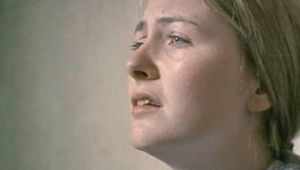
Patricia got pregnant before marriage, and she had her son taken away, and then she got admitted to the Asylum. In the scene (from 2:06 to 2:34) Patricia is pushing a laundry cart through the hallway and notices a nun taking away another girl’s child, leaving it in the care of the girl’s mother. The nun, after rushing out of the girl’s room, leads the mother to sign the necessary paperwork. Patricia slowly pushes the cart through the hallway and walks past the room with the open door, looking at the girl whose child has been taken away, just like hers. You can see the empathy in Patricia’s facial expression as she makes eye contact with the new girl. The girl looks frightened and devastated. She is sitting in the hospital bed with her suitcase filled with clothes widely open. Patricia looks away and steadily pushes the cart farther. The camera focused on showing the girls’ emotions. I think when they captured the newcomer’s facial expression when she looked into Patricia’s eyes with fear, the producer may have implied that she understood how Patricia can relate to this incident. Showing the emotions leaves a big impact on the viewer. In terms of lighting, I don’t think they used any artificial lights in the hallway, because the scene was quite dark. The producers might have chosen to do so to make this part of the scene more depressing and, therefore, making a bigger emotional impact on the audience.
The main characters are the four girls – Bernadette, Patricia, Crispina and Margaret. Bernadette is a beautiful orphan who got sent to the Asylum because she was flirting with boys at the orphanage. She is a virgin. She has a rebellious attitude, and it is no wonder she despises living in the Asylum. Patricia’s actual name is Rose Dunne; her name was changed when she arrived at the Asylum because there was already a girl named Rose there. She conceived a child before getting married and, as stated before, had her child taken away. She is ready to do a lot of hard work in hopes she will be able to meet her son after she repays her sins. Crispina was also sent to the laundry for having a child out of wedlock. Crispina’s actual name is Harriet, the nuns gave her that nickname because she has the most pubic hair out of all the girls. She is poorly educated and believes she deserves how the nuns treat her. Finally, Margaret is a victim of rape, who got sent to the laundry because her father believes she was being provocative. She notices Crispina is emotionally weak, so she tries to help her however she can, though it sometimes ends up hurting Crispina in some way. The antagonists are the nuns who can be compared to the guards in Shawshank Redemption. Sister Bridget is the head of the Asylum. She is a greedy, hypocritical, sadistic liar who is soft-spoken and pretends to truly follow the word of God. Another antagonist is the priest who molested Crispina, and though his appearances were dramatic and crucial to the plot, you don’t get to see him often.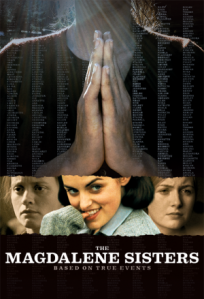
The narrative of the movie is linear. The characters’ lives are shown chronologically. There were no voiceovers in the movie, but at the end the girls’ fates were displayed via text on the screen. The set up comprised of introducing the girls and how they ended up in the laundry. The conflict mainly showed how the girls are mistreated and harassed by the nuns, and how those four girls deal with it. The resolution presented how Margaret, Bernadette and Patricia get out of the Asylum, and what happened to them afterwards. It also showed the fate of Crispina and how her life ended.
The main themes dealt with are institutionalization, inhumane treatment against the girls, friendship, hope and also fear. The key message of the movie is that what happened to these women at the Asylums was brutal and unfair. The women whose experiences the movie was based on said that in reality the women were mistreated much more badly. It makes people feel empathy for what happened to those poor girls, and the movie definitely makes a large impact.
Filmmakers keep their audience interested by making original content, but keeping the basic elements of the genre. Prison films are popular because they portray social dramas about incarceration. They all have similar plot elements, but the writers may take a different approach to certain aspects and present the genre movie in a new way.
Excellent work. You need to explore your final comment about the prison genre in more detail. Why do audiences like the prison genre so much ? I think you need to mention the fact that the convents were religious centres that exploited the young women who had been thought to ‘transgress’ society’s moral code.